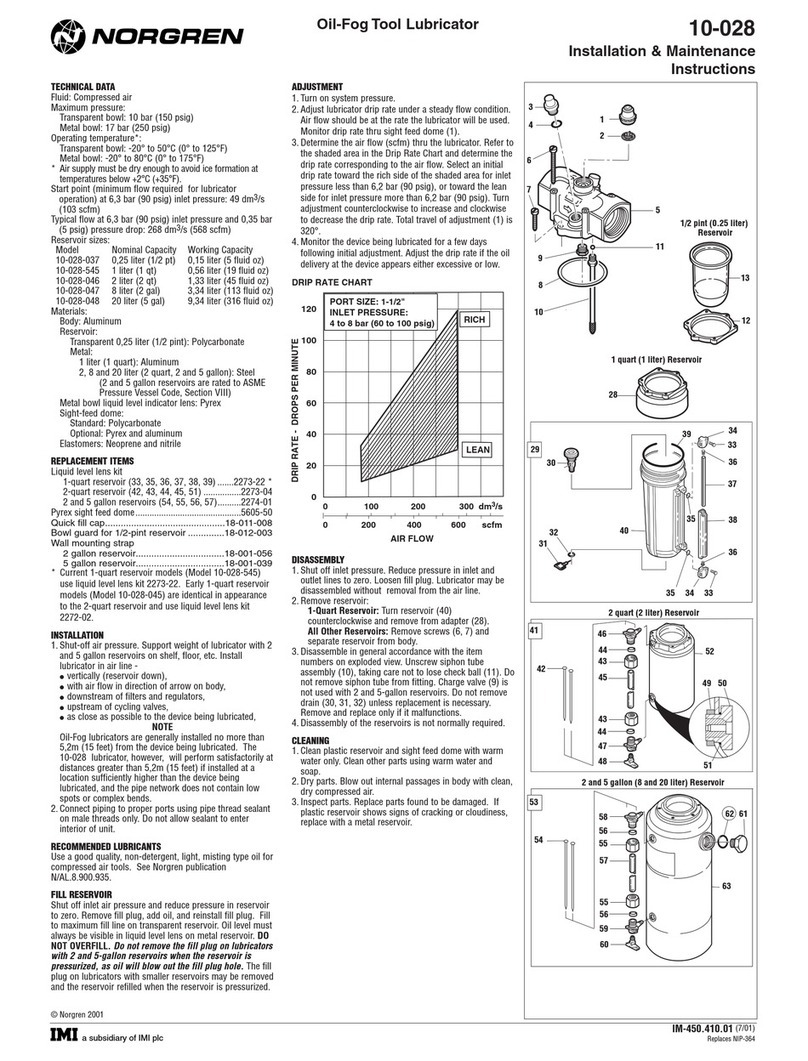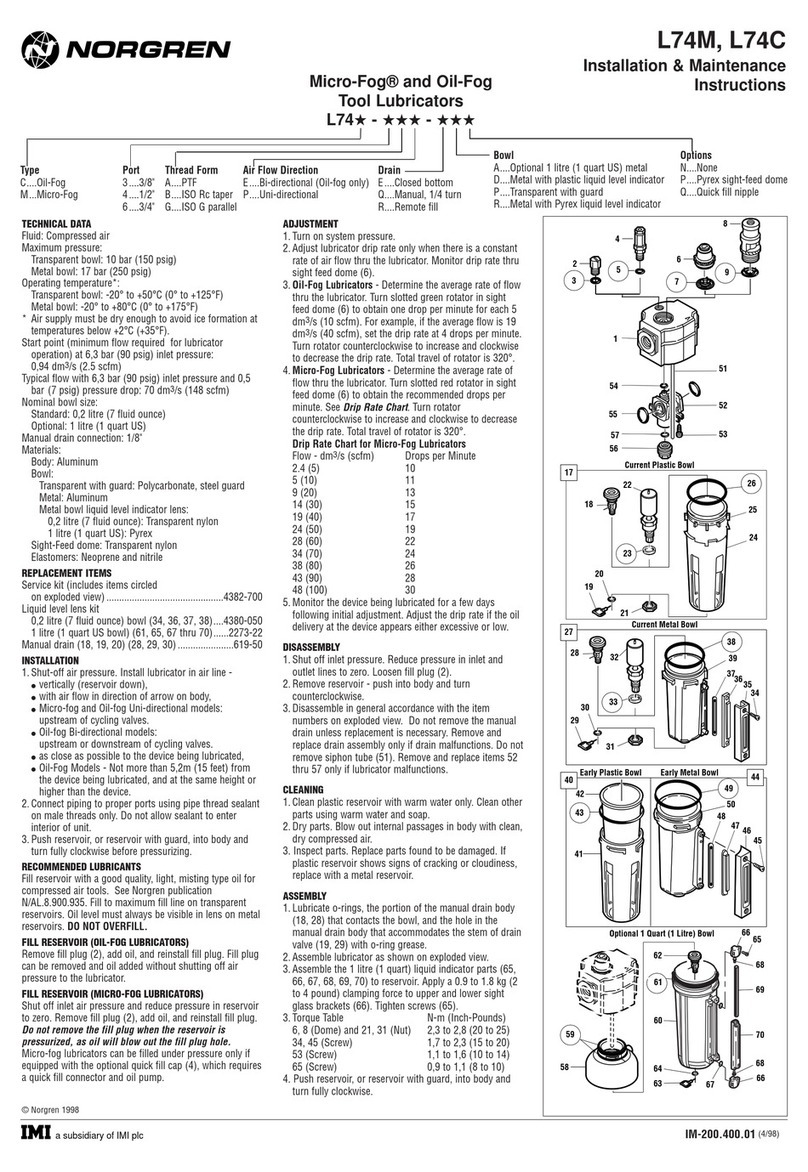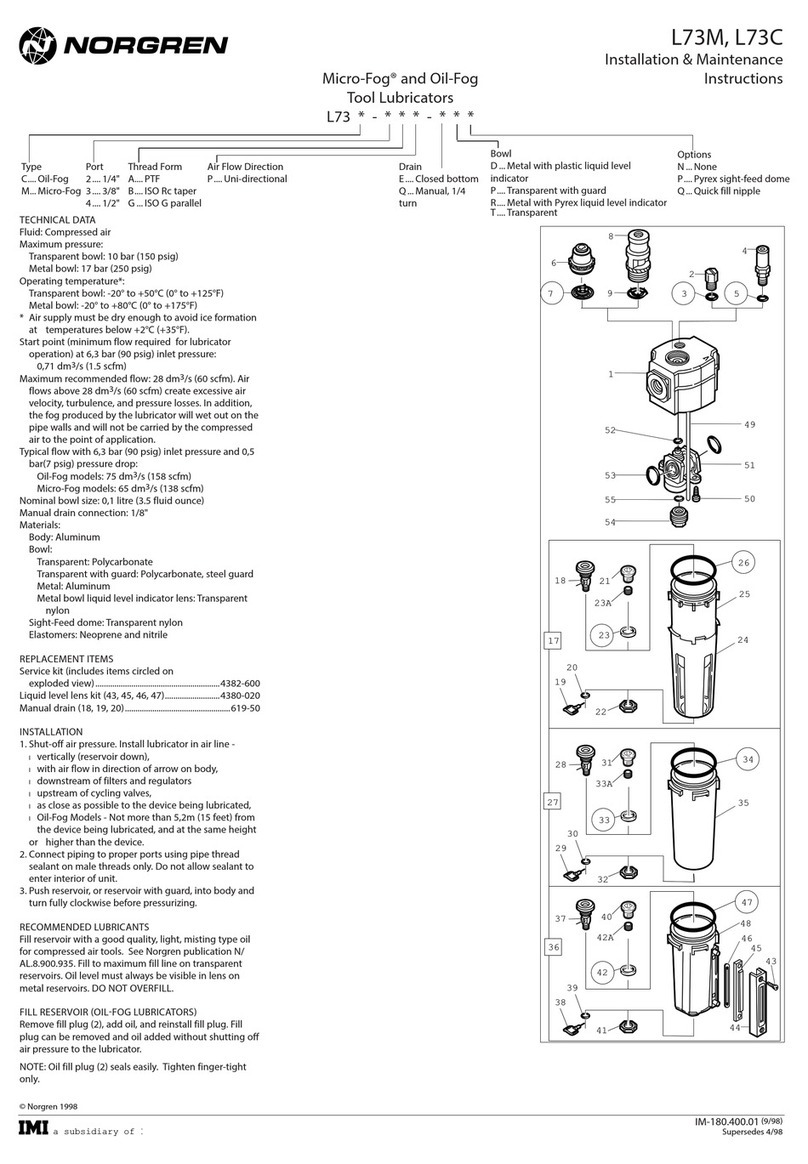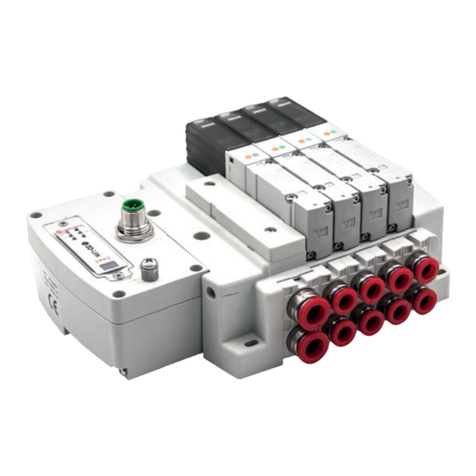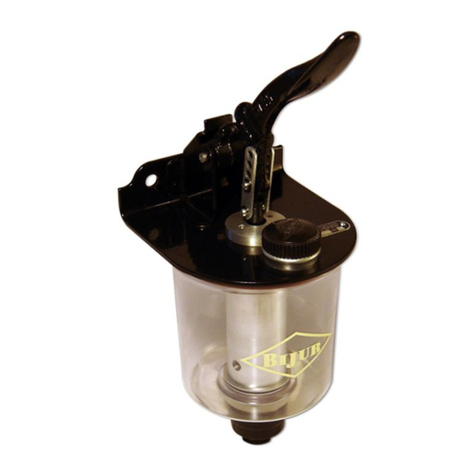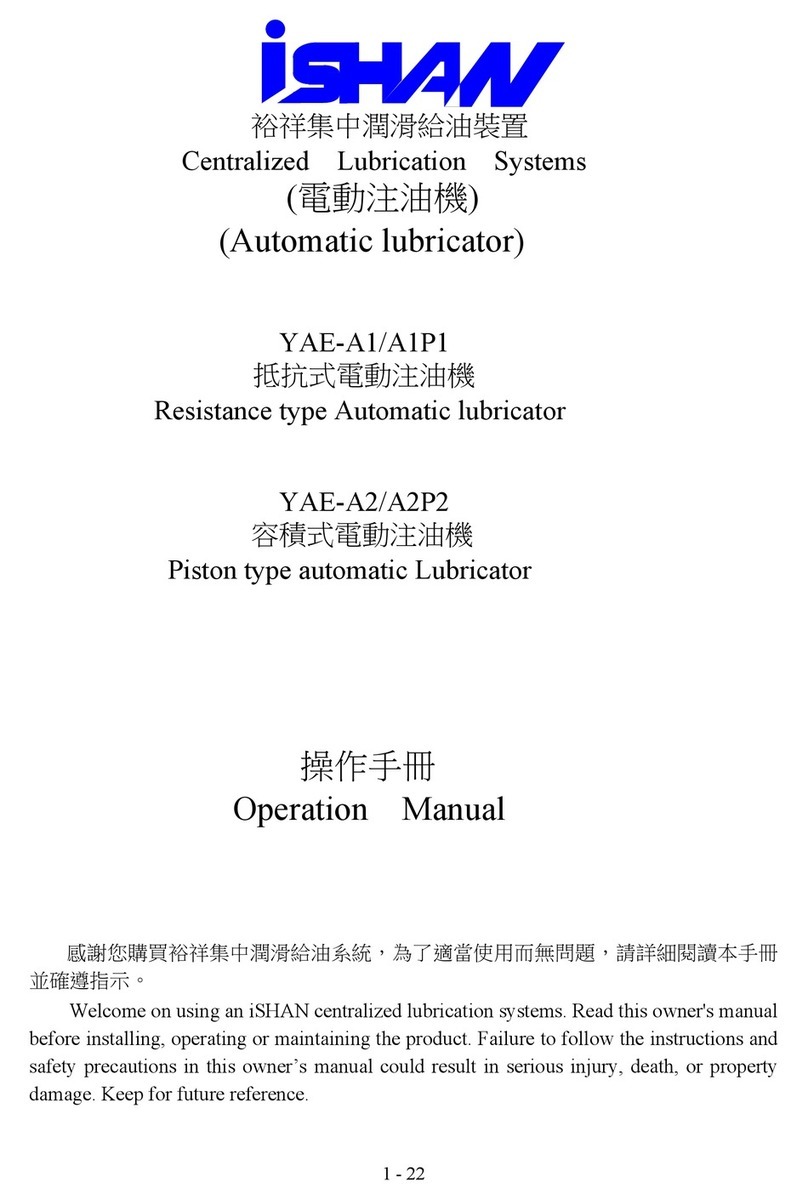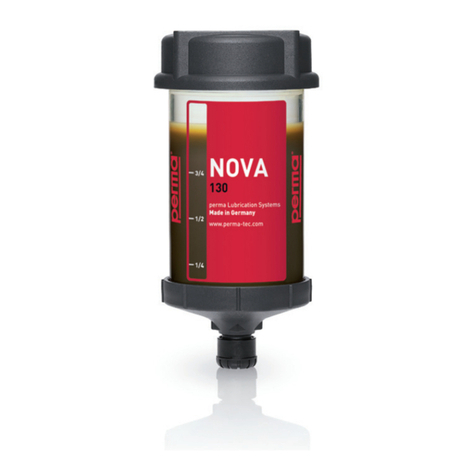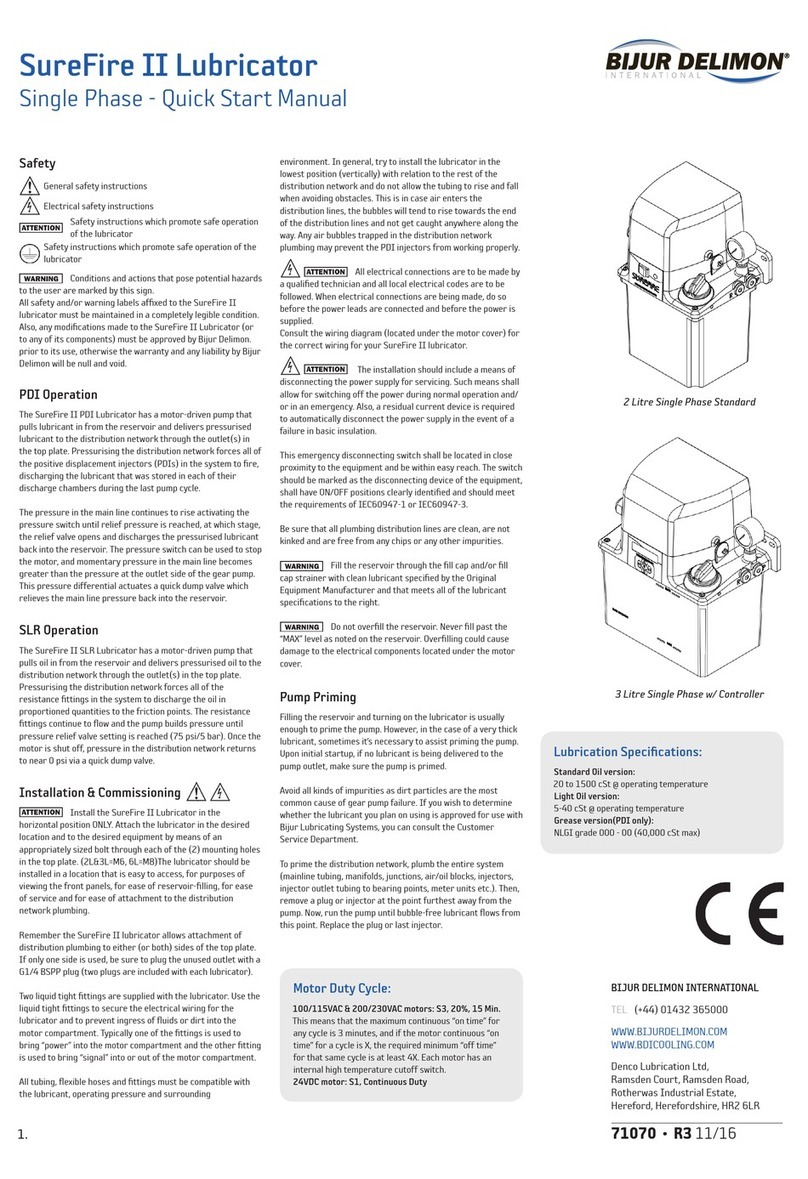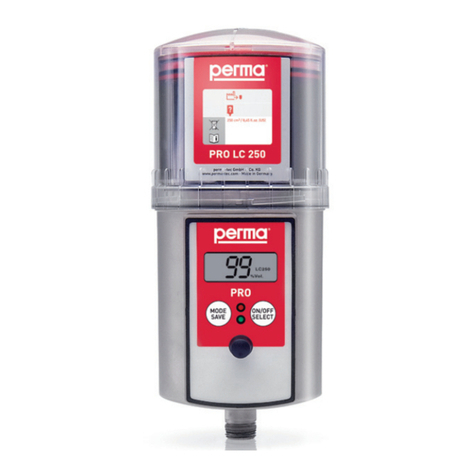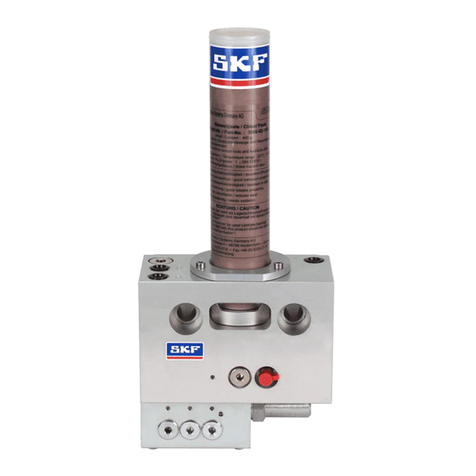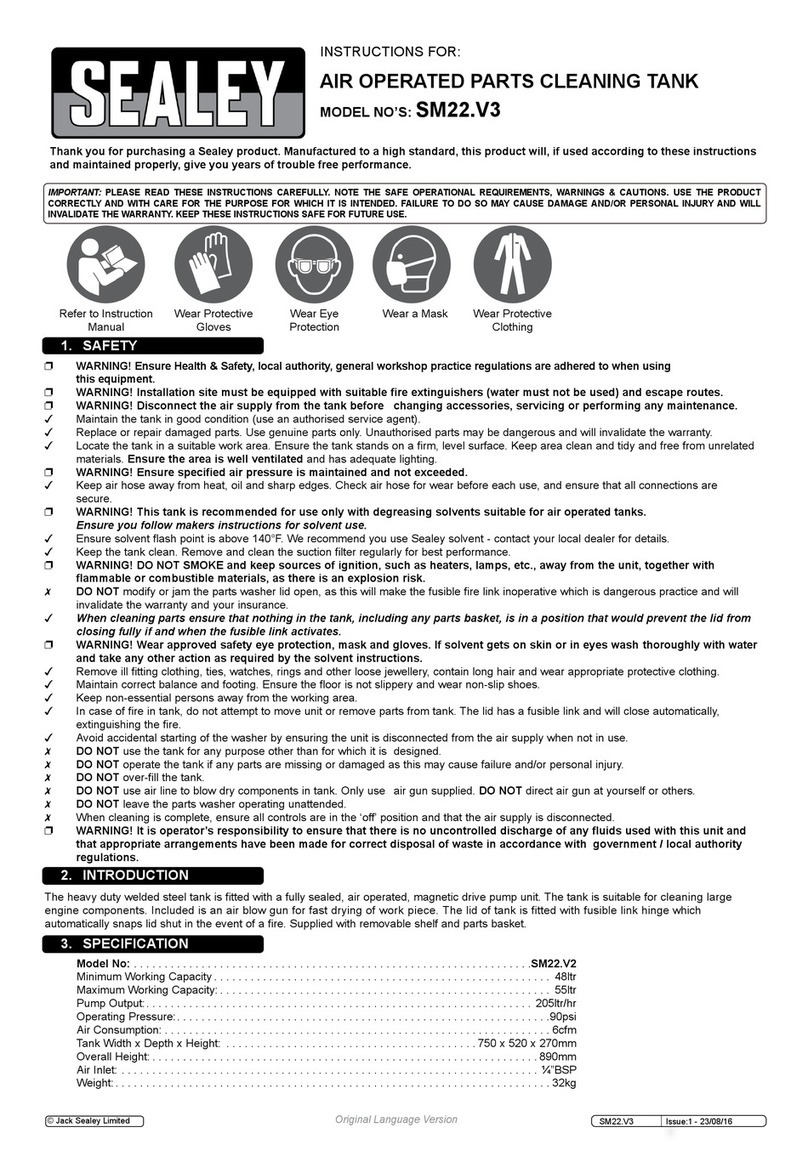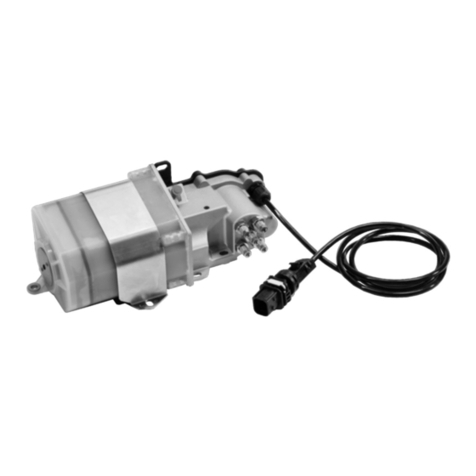Norgren L64C Installation and operating instructions

Our policy is one of continued research and development. We therefore reserve the right to amend,
without notice, the specifications given in this document. (1999 - I&M8074d) © 2020 IMI International s.r.o. 4/19
I&M/en 8.240.400.1
L64C, L64M Lubricator
Installation & Maintenance Instructions
Thread
A PTF
B ISO Rc taper
G ISO G parallel
N No thread (basic
unit)
L64H- HHP - HHN
Port
2 1/4“
3 3/8“
4 1/2“
6 3/4“
Operator
C Oil-Fog
M Micro-Fog
Drain
M Manual
E No drain (Closed Bowl)
Q Manual 1/4 turn
R Remote ill
Bowl/Reservoir
A optional 1 litre (1 quart US) metal
D Metal
P Transparent with guard
R Metal with Pyrex liquid level
indicator
TECHNICAL DATA
Fluid: Compressed air
Maximum pressure:
Guarded transparent bowl: 10 bar (150 psig)
Metal bowl: 17 bar (250 psig)
Operating temperature*:
Transparent bowl: –20° to +50°C (0° to +125°F)
Metal bowl: –20° to +80°C (0° to +175°F)
* Air supply must be dry enough to avoid ice formation at
temperatures below +2°C (+35°F).
Start point (minimum low required for lubricator
operation) at 6,3 bar (90 psig) inlet pressure:
1,5 dm3/s (3.2 scfm)
Nominal bowl capacity: 0,2 litre (7 luid oz), standard
1 litre (1 quart US), optional
Materials:
Body: Zinc
Bowl:
Metal: Aluminium
Transparent, optional: Polycarbonate
Metal bowl liquid level indicator lens, standard: Grilamid
Metal bowl sight glass, optional (standard on 1 litre
bowl): Pyrex
Sight dome: Polycarbonate
Elastomers: Synthetic rubber)
REPLACEMENT ITEMS
Service kit, contains required items circled: ..........4382-200
Prismatic sight glass...................................................4380-042
Pyrex sight glass...........................................................4380-041
Pyrex sight glass, 1 litre bowl.....................................2273-22
Manual drain .................................................................684-84
INSTALLATION
1. Install unit vertically in air line -
• vertically (bowl down),
• with air flow in direction of arrow on body,
• upstream of cycling valves
• as close as possible to the device being lubricated,
• Oil-Fog Models - Not more than 5,2m (15 feet) from the
device being lubricated, and at the same height or higher
than the device.
2. Before assembling the basic unit into the yoke the port
seal o-rings should be lightly smeared with o-ring grease.
3. Locate clamp ring under lugs on top of yoke, offer basic
unit into yoke with directional arrows correctly aligned
(an interference fit prevents assembly if misaligned)
before engaging and fully tightening the clamp ring.
4. Turn bowl or bowl guard fully clockwise into body before
pressurizing. Lock symbols on body and bowl guards
must align.
RECOMMENDED LUBRICANTS
Fill reservoir with a good quality, light, misting type oil for
compressed air tools. See our publication N/AL.8.900.935.
Fill to maximum ill line on transparent reservoirs. Oil level
must always be visible in lens on metal reservoirs. Do not
overill.
FILL RESERVOIR OILFOG LUBRICATORS
Remove ill plug (1), add oil, and reinstall ill plug. Fill plug
can be removed and oil added without shutting off air
pressure to the lubricator.
FILL RESERVOIR MICROFOG LUBRICATORS
Shut off inlet air pressure and reduce pressure in reservoir
to zero. Remove ill plug (1), add oil, and reinstall ill plug. Do
not remove the ill plug when the reservoir is
pressurized, as oil will blow out the ill plug hole.
ADJUSTMENT
1. Turn on system pressure.
2. Adjust lubricator drip rate only when there is a constant
rate of air flow through the lubricator. Monitor drip rate
through sight feed dome (3).
3. Oil-Fog Lubricators - Determine the average rate of flow
through the lubricator. Turn green knob (3) to obtain one
drop per minute for each 5 dm3/s (10 scfm). For example, if
the average flow is 19 dm3/s (40 scfm), set the drip rate at
4 drops per minute. Turn knob counterclockwise to increase
and clockwise to decrease the drip rate. The oil feed setting
can be locked by pushing the lock ring down, this must be
released before adjustment by pulling up.
4. Micro-Fog Lubricators - Oil drip rate is adjusted by
the red knob above the sight-feed dome, counterclock-
wise to increase and clockwise to decrease the drip rate.
The rate changes automatically to compensate for flow
variations. The oil feed setting can be locked by pushing
the lock ring down, this must be released before adjust-
ment by pulling up. See Drip Rate Chart. Turn knob
counterclockwise to increase and clockwise to decrease
the drip rate.
Drip Rate Chart for Micro-Fog Lubricators
Flow - dm3/s (scfm) Drops per Minute
2,4 (5) 10
5 (10) 11
9 (20) 13
14 (30) 15
19 (40) 17
24 (50) 19
28 (60) 22
34 (70) 24
38 (80) 26
43 (90) 28
48 (100) 30
5. Monitor the device being lubricated for a few days
following initial adjustment. Adjust the drip rate if the oil
delivery at the device appears either excessive or low.
DISASSEMBLY
1. Shut off inlet pressure. Reduce pressure in inlet and outlet
lines to zero. Loosen fill plug (1).
2. Remove reservoir - push into body and turn counterc-
lockwise.
3. Disassemble in general accordance with the item num-
bers on exploded view. Do not remove the manual drain
unless replacement is necessary. Remove and replace
drain assembly only if drain malfunctions. Do not remove
syphon tube (53). Remove and replace items 54 through
59 only if lubricator malfunctions.
ADJUSTMENT
1. Turn on system pressure.
2. Adjust lubricator drip rate only when there is a constant
rate of air flow through the lubricator. Monitor drip rate
through sight feed dome (3).
3. Oil-Fog Lubricators - Determine the average rate of flow
through the lubricator. Turn green knob (3) to obtain one
drop per minute for each 5 dm3/s (10 scfm). For
example, if the average flow is 19 dm3/s (40 scfm), set
the drip rate at 4 drops per minute. Turn knob
counterclockwise to increase and clockwise to decrease
the drip rate. The oil feed setting can be locked by
pushing the lock ring down, this must be released before
adjustment by pulling up.
4. Micro-Fog Lubricators - Oil drip rate is adjusted by the
red knob above the sight-feed dome, counterclockwise to
increase and clockwise to decrease the drip rate. The rate
changes automatically to compensate for flow variations.
The oil feed setting can be locked by pushing the lock
ring down, this must be released before adjustment by
pulling up.
See Drip Rate Chart. Turn knob counterclockwise to
increase and clockwise to decrease the drip rate.
Drip Rate Chart for Micro-Fog Lubricators
Flow - dm3/s (scfm) Drops per Minute
2,4 (5) 10
5 (10) 11
9 (20) 13
14 (30) 15
19 (40) 17
24 (50) 19
28 (60) 22
34 (70) 24
38 (80) 26
43 (90) 28
48 (100) 30
5. Monitor the device being lubricated for a few days
following initial adjustment. Adjust the drip rate if the oil
delivery at the device appears either excessive or low.
DISASSEMBLY
1. Shut off inlet pressure. Reduce pressure in inlet and
outlet lines to zero. Loosen fill plug (1).
2. Remove reservoir - push into body and turn
counterclockwise.
3. Disassemble in general accordance with the item
numbers on exploded view. Do not remove the manual
drain unless replacement is necessary. Remove and
replace drain assembly only if drain malfunctions. Do not
remove syphon tube (53). Remove and replace items 54
through 59 only if lubricator malfunctions.
CLEANING
1. Clean plastic reservoir with warm water only. Clean other
parts using warm water and soap.
2. Dry parts. Blow out internal passages in body with clean,
dry compressed air.
3. Inspect parts. Replace parts found to be damaged. If
plastic reservoir shows signs of cracking or cloudiness,
replace with a metal reservoir.
ASSEMBLY
1. Lubricate o-rings, the portion of the manual drain body
(19, 33) that contacts the bowl, and the hole in the
manual drain body that accommodates the stem of drain
valve (20, 34) with o-ring grease.
2. Assemble lubricator as shown on exploded view.
3. Assemble the 1 litre (1 quart) liquid indicator parts (69
through 74) to reservoir. Apply a 0,9 to 1,8 kg (2 to 4
pound) clamping force to upper and lower sight glass
brackets (70). Tighten screws (69).
3. Torque Table N-m (Inch-Pounds)
3 (Dome) 2,3 to 2,8 (20 to 25)
43 (Screw) 1,7 to 2,3 (15 to 20)
55 (Screw) 1,1 to 1,6 (10 to 14)
69 (Screw) 0,9 to 1,1 (8 to 10)
4. Push reservoir, or reservoir with guard, into body and
turn fully clockwise.
TECHNICAL DATA
Fluid: Compressed air
Maximum pressure:
Guarded transparent bowl: 10 bar (150 psig)
Metal bowl: 17 bar (250 psig)
Operating temperature*:
Transparent bowl: –20° to +50°C (0° to +125°F)
Metal bowl: –20° to +80°C (0° to +175°F)
* Air supply must be dry enough to avoid ice formation at
temperatures below +2°C (+35°F).
Start point (minimum flow required for lubricator
operation) at 6,3 bar (90 psig) inlet pressure:
1,5 dm3/s (3.2 scfm)
Nominal bowl capacity: 0,2 litre (7 fluid oz), standard
1 litre (1 quart US), optional
Materials:
Body: Zinc
Bowl:
Metal: Aluminium
Transparent, optional: Polycarbonate
Metal bowl liquid level indicator lens,
standard: Grilamid
Metal bowl sight glass, optional (standard on
1 litre bowl): Pyrex
Sight dome: Polycarbonate
Elastomers: Synthetic rubber
REPLACEMENT ITEMS
Service kit, contains required items circled: ..........4382-200
Prismatic sight glass..............................................4380-042
Pyrex sight glass....................................................4380-041
Pyrex sight glass, 1 litre bowl..................................2273-22
Manual drain ..............................................................684-84
INSTALLATION
1. Install unit vertically in air line -
●vertically (bowl down),
●with air flow in direction of arrow on body,
●upstream of cycling valves
●as close as possible to the device being lubricated,
●Oil-Fog Models - Not more than 5,2m (15 feet) from
the device being lubricated, and at the same height or
higher than the device.
2. Before assembling the basic unit into the yoke the port
seal o-rings should be lightly smeared with o-ring
grease.
3. Locate clamp ring under lugs on top of yoke, offer basic
unit into yoke with directional arrows correctly aligned
(an interference fit prevents assembly if misaligned)
before engaging and fully tightening the clamp ring.
4. Turn bowl or bowl guard fully clockwise into body before
pressurizing. Lock symbols on body and bowl guards
must align.
RECOMMENDED LUBRICANTS
Fill reservoir with a good quality, light, misting type oil
for compressed air tools. See our publication
N/AL.8.900.935. Fill to maximum fill line on transparent
reservoirs. Oil level must always be visible in lens on metal
reservoirs. Do not overfill.
FILL RESERVOIR (OIL-FOG LUBRICATORS)
Remove fill plug (1), add oil, and reinstall fill plug. Fill
plug can be removed and oil added without shutting off air
pressure to the lubricator.
FILL RESERVOIR (MICRO-FOG LUBRICATORS)
Shut off inlet air pressure and reduce pressure in
reservoir to zero. Remove fill plug (1), add oil, and reinstall
fill plug. Do not remove the fill plug when the reservoir is
pressurized, as oil will blow out the fill plug hole.
………continued over
L64★ - ★★P- ★★N
Port
2.....1/4"
3.....3/8"
4.....1/2"
6.....3/4"
Thread
A ....PTF
B ....ISO Rctaper
G ....ISO G parallel
N ....No thread (basic unit)
Bowl/Reservoir
A ....optional 1 litre (1 quart US) metal
D ....Metal
P ....Transparent with guard
R ....Metal with Pyrex liquid level indicator
Operation
C ....Oil-Fog
M ...Micro-Fog
Drain
M ...Manual
E.....No drain (Closed bowl)
Q ....Manual 1/4 turn
R ....Remote fill
AB
C
48
32
47
Current Plastic Bowl
18
31
30
29
43
44
4645
36
38
37
39
33
35
34
56
54
58
59
67
66
72 73
70
74
63
69
71
65
68
64
62
55
57
1
2
9
53
3
4
5
9
6
8
7
22
24
23
25
19
21
20
61
60
Early Plastic Bowl
and Guard.
No Longer Available
Replaced by Item 18
L64C, L64M - Lubricator
Installation & Maintenance Instructions
IM-240.400 (7/99)
Our policy is one of continued research and development. We therefore reserve the right to amend, without notice,
the specifications given in this document. © 1999 Norgren, Inc.
ADJUSTMENT
1. Turn on system pressure.
2. Adjust lubricator drip rate only when there is a constant
rate of air flow through the lubricator. Monitor drip rate
through sight feed dome (3).
3. Oil-Fog Lubricators - Determine the average rate of flow
through the lubricator. Turn green knob (3) to obtain one
drop per minute for each 5 dm3/s (10 scfm). For
example, if the average flow is 19 dm3/s (40 scfm), set
the drip rate at 4 drops per minute. Turn knob
counterclockwise to increase and clockwise to decrease
the drip rate. The oil feed setting can be locked by
pushing the lock ring down, this must be released before
adjustment by pulling up.
4. Micro-Fog Lubricators - Oil drip rate is adjusted by the
red knob above the sight-feed dome, counterclockwise to
increase and clockwise to decrease the drip rate. The rate
changes automatically to compensate for flow variations.
The oil feed setting can be locked by pushing the lock
ring down, this must be released before adjustment by
pulling up.
See Drip Rate Chart. Turn knob counterclockwise to
increase and clockwise to decrease the drip rate.
Drip Rate Chart for Micro-Fog Lubricators
Flow - dm3/s (scfm) Drops per Minute
2,4 (5) 10
5 (10) 11
9 (20) 13
14 (30) 15
19 (40) 17
24 (50) 19
28 (60) 22
34 (70) 24
38 (80) 26
43 (90) 28
48 (100) 30
5. Monitor the device being lubricated for a few days
following initial adjustment. Adjust the drip rate if the oil
delivery at the device appears either excessive or low.
DISASSEMBLY
1. Shut off inlet pressure. Reduce pressure in inlet and
outlet lines to zero. Loosen fill plug (1).
2. Remove reservoir - push into body and turn
counterclockwise.
3. Disassemble in general accordance with the item
numbers on exploded view. Do not remove the manual
drain unless replacement is necessary. Remove and
replace drain assembly only if drain malfunctions. Do not
remove syphon tube (53). Remove and replace items 54
through 59 only if lubricator malfunctions.
CLEANING
1. Clean plastic reservoir with warm water only. Clean other
parts using warm water and soap.
2. Dry parts. Blow out internal passages in body with clean,
dry compressed air.
3. Inspect parts. Replace parts found to be damaged. If
plastic reservoir shows signs of cracking or cloudiness,
replace with a metal reservoir.
ASSEMBLY
1. Lubricate o-rings, the portion of the manual drain body
(19, 33) that contacts the bowl, and the hole in the
manual drain body that accommodates the stem of drain
valve (20, 34) with o-ring grease.
2. Assemble lubricator as shown on exploded view.
3. Assemble the 1 litre (1 quart) liquid indicator parts (69
through 74) to reservoir. Apply a 0,9 to 1,8 kg (2 to 4
pound) clamping force to upper and lower sight glass
brackets (70). Tighten screws (69).
3. Torque Table N-m (Inch-Pounds)
3 (Dome) 2,3 to 2,8 (20 to 25)
43 (Screw) 1,7 to 2,3 (15 to 20)
55 (Screw) 1,1 to 1,6 (10 to 14)
69 (Screw) 0,9 to 1,1 (8 to 10)
4. Push reservoir, or reservoir with guard, into body and
turn fully clockwise.
TECHNICAL DATA
Fluid: Compressed air
Maximum pressure:
Guarded transparent bowl: 10 bar (150 psig)
Metal bowl: 17 bar (250 psig)
Operating temperature*:
Transparent bowl: –20° to +50°C (0° to +125°F)
Metal bowl: –20° to +80°C (0° to +175°F)
* Air supply must be dry enough to avoid ice formation at
temperatures below +2°C (+35°F).
Start point (minimum flow required for lubricator
operation) at 6,3 bar (90 psig) inlet pressure:
1,5 dm3/s (3.2 scfm)
Nominal bowl capacity: 0,2 litre (7 fluid oz), standard
1 litre (1 quart US), optional
Materials:
Body: Zinc
Bowl:
Metal: Aluminium
Transparent, optional: Polycarbonate
Metal bowl liquid level indicator lens,
standard: Grilamid
Metal bowl sight glass, optional (standard on
1 litre bowl): Pyrex
Sight dome: Polycarbonate
Elastomers: Synthetic rubber
REPLACEMENT ITEMS
Service kit, contains required items circled: ..........4382-200
Prismatic sight glass..............................................4380-042
Pyrex sight glass....................................................4380-041
Pyrex sight glass, 1 litre bowl..................................2273-22
Manual drain ..............................................................684-84
INSTALLATION
1. Install unit vertically in air line -
●vertically (bowl down),
●with air flow in direction of arrow on body,
●upstream of cycling valves
●as close as possible to the device being lubricated,
●Oil-Fog Models - Not more than 5,2m (15 feet) from
the device being lubricated, and at the same height or
higher than the device.
2. Before assembling the basic unit into the yoke the port
seal o-rings should be lightly smeared with o-ring
grease.
3. Locate clamp ring under lugs on top of yoke, offer basic
unit into yoke with directional arrows correctly aligned
(an interference fit prevents assembly if misaligned)
before engaging and fully tightening the clamp ring.
4. Turn bowl or bowl guard fully clockwise into body before
pressurizing. Lock symbols on body and bowl guards
must align.
RECOMMENDED LUBRICANTS
Fill reservoir with a good quality, light, misting type oil
for compressed air tools. See our publication
N/AL.8.900.935. Fill to maximum fill line on transparent
reservoirs. Oil level must always be visible in lens on metal
reservoirs. Do not overfill.
FILL RESERVOIR (OIL-FOG LUBRICATORS)
Remove fill plug (1), add oil, and reinstall fill plug. Fill
plug can be removed and oil added without shutting off air
pressure to the lubricator.
FILL RESERVOIR (MICRO-FOG LUBRICATORS)
Shut off inlet air pressure and reduce pressure in
reservoir to zero. Remove fill plug (1), add oil, and reinstall
fill plug. Do not remove the fill plug when the reservoir is
pressurized, as oil will blow out the fill plug hole.
………continued over
L64★ - ★★P- ★★N
Port
2.....1/4"
3.....3/8"
4.....1/2"
6.....3/4"
Thread
A ....PTF
B ....ISO Rctaper
G ....ISO G parallel
N ....No thread (basic unit)
Bowl/Reservoir
A ....optional 1 litre (1 quart US) metal
D ....Metal
P ....Transparent with guard
R ....Metal with Pyrex liquid level indicator
Operation
C ....Oil-Fog
M ...Micro-Fog
Drain
M ...Manual
E.....No drain (Closed bowl)
Q ....Manual 1/4 turn
R ....Remote fill
AB
C
48
32
47
Current Plastic Bowl
18
31
30
29
43
44
4645
36
38
37
39
33
35
34
56
54
58
59
67
66
72 73
70
74
63
69
71
65
68
64
62
55
57
1
2
9
53
3
4
5
9
6
8
7
22
24
23
25
19
21
20
61
60
Early Plastic Bowl
and Guard.
No Longer Available
Replaced by Item 18
L64C, L64M - Lubricator
Installation & Maintenance Instructions
IM-240.400 (7/99)
Our policy is one of continued research and development. We therefore reserve the right to amend, without notice,
the specifications given in this document. © 1999 Norgren, Inc.

Our policy is one of continued research and development. We therefore reserve the right to amend,
without notice, the specifications given in this document. (1999 - I&M8074d) © 2020 IMI International s.r.o.
L64C, L64M Lubricator
Installation & Maintenance Instructions
4/19
I&M/en 8.240.400.2
CLEANING
1. Clean plastic reservoir with warm water only. Clean other
parts using warm water and soap.
2. Dry parts. Blow out internal passages in body with clean,
dry compressed air.
3. Inspect parts. Replace parts found to be damaged. If
plastic reservoir shows signs of cracking or cloudiness,
replace with a metal reservoir.
ASSEMBLY
1. Lubricate o-rings, the portion of the manual drain body
(19, 33) that contacts the bowl, and the hole in the ma-
nual drain body that accommodates the stem of drain
valve (20, 34) with o-ring grease.
2. Assemble lubricator as shown on exploded view.
3. Assemble the 1 litre (1 quart) liquid indicator parts (69
through 74) to reservoir. Apply a 0,9 to 1,8 kg (2 to 4
pound) clamping force to upper and lower sight glass
brackets (70). Tighten screws (69).
Torque Table N-m (Inch-Pounds)
3 (Dome) 2,3 to 2,8 (20 to 25)
43 (Screw) 1,7 to 2,3 (15 to 20)
55 (Screw) 1,1 to 1,6 (10 to 14)
69 (Screw) 0,9 to 1,1 (8 to 10)
4. Push reservoir, or reservoir with guard, into body and turn
fully clockwise.
WARNING
These products are intended for use in industrial
compressed air systems only. Do not use these products
where pressures and temperatures can exceed those listed
under Technical Data.
Polycarbonate plastic bowls can be damaged and possibly
burst if exposed to such substances as certain solvents,
strong alkalies, compressor oils containing esterbased
additives or synthetic oils. Fumes of these substances in
contact with the polycarbonate bowl, externally or
internally, can also result in damage. Clean with warm
water only.
Use metal bowl in applications where a plastic bowl might
be exposed to substances that are incompatible with
polycarbonate.
Before using these products with luids other than air, for
non industrial applications, or for life-support systems
consult IMI Precision Engineering.
Use in potentially explosive atmospheres
Code of device according EC directive
2014/34/EU
II 2G Ex h IIC T6 Gb
II 2D Ex h IIIC T85ºC Db
• Only non-lammable gasese to be used as a medium.
• Surface temperature dependant on process luid
temperature and ambient temperature - must be below
the ignition temperature of the lammable gas or dust.
• Earth unit and/or pipework to avoid electrostatic
discharge.
• Precautions should be taken to prevent hazard from
adiabatic compression.
• Use wet cloth for cleaning.
• Protect the unit from object falling onto it.
• Avoid contact with corrosive environment.
• For servicing the unit it is recommended to carry out this
work outside of the danger zone.
• For details of ignition hazard assessment contact
Norgren.
This manual suits for next models
1
Other Norgren Lubrication System manuals
Popular Lubrication System manuals by other brands

DROPSA
DROPSA VIP4Air Series User and maintenance manual
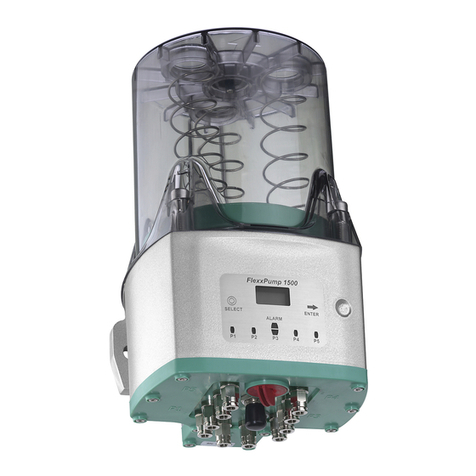
DLS
DLS FlexxPump 1500 user guide
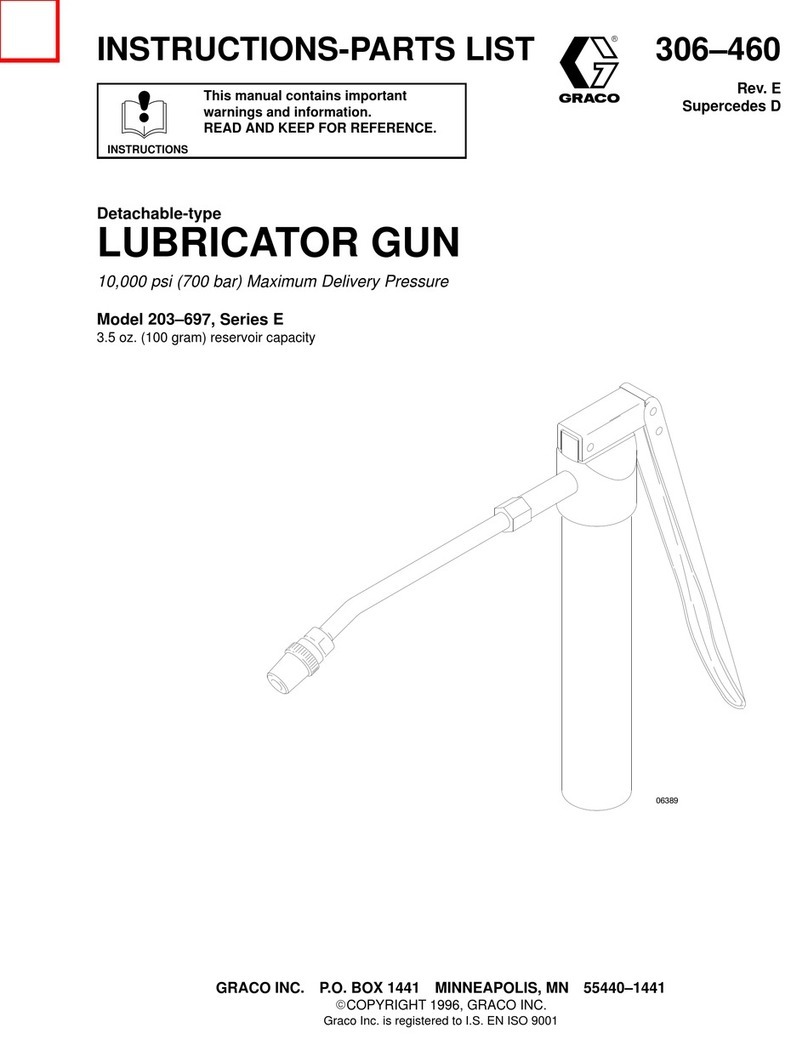
Graco
Graco 203-697 E Series Instructions-parts list
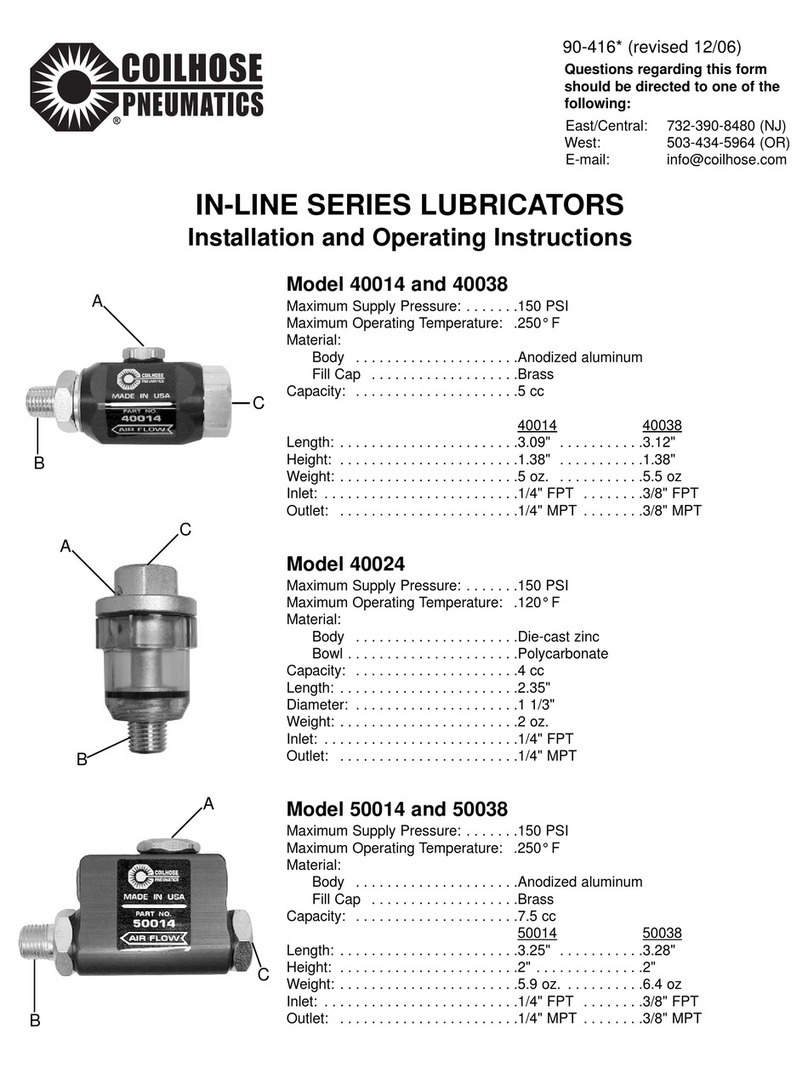
Coilhose Pneumatics
Coilhose Pneumatics IN-LINE Series Installation and operating instructions
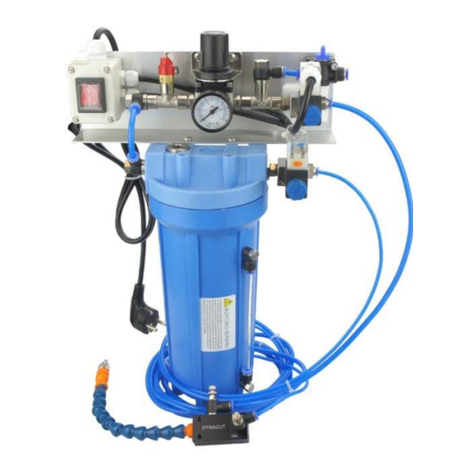
Dynacut
Dynacut MDE Operation manual
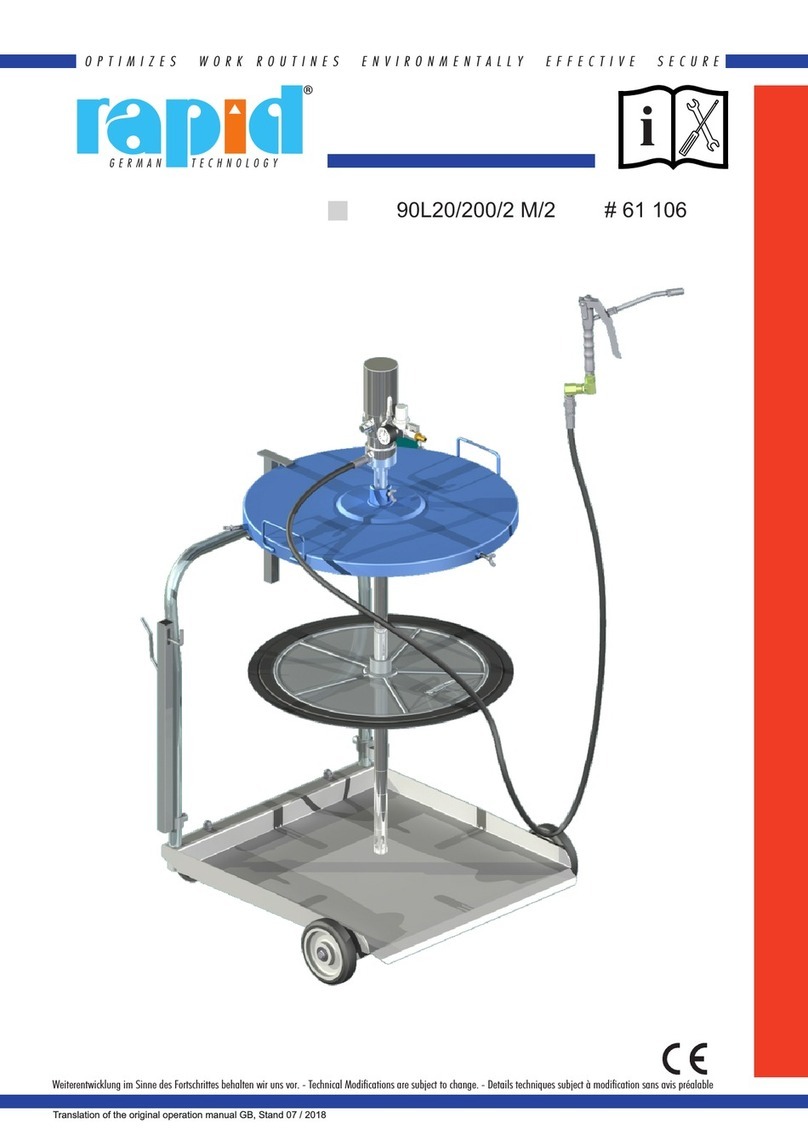
Rapid
Rapid 90 L 20/200/1 M Operation manual
